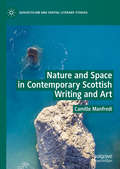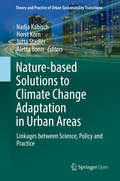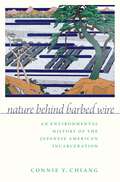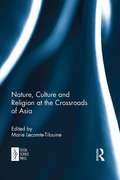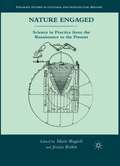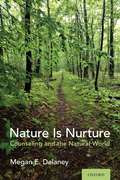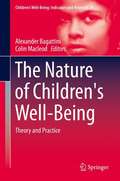- Table View
- List View
Nature and Society: Anthropological Perspectives (European Association of Social Anthropologists #93)
by Philippe Descola Gísli PálssonThe contributors to this book focus on the relationship between nature and society from a variety of theoretical and ethnographic perspectives. Their work draws upon recent developments in social theory, biology, ethnobiology, epistemology, sociology of science, and a wide array of ethnographic case studies -- from Amazonia, the Solomon Islands, Malaysia, the Mollucan Islands, rural comunities from Japan and north-west Europe, urban Greece, and laboratories of molecular biology and high-energy physics. The discussion is divided into three parts, emphasising the problems posed by the nature-culture dualism, some misguided attempts to respond to these problems, and potential avenues out of the current dilemmas of ecological discourse.
Nature and Space in Contemporary Scottish Writing and Art (Geocriticism and Spatial Literary Studies)
by Camille ManfrediThis book examines how contemporary Scottish writers and artists revisit and reclaim nature in the political and aesthetic context of devolved Scotland. Camille Manfredi investigates the interaction of landscape aesthetics and strategies of spatial representation in Scotland’s twenty-first-century literature and arts, focusing on the apparatuses designed by nature writers, poets, performers, walking artists and visual artists to physically and intellectually engage with the land and re-present it to themselves and to the world. Through a comprehensive analysis of a variety of site-specific artistic practices, artworks and publications, this book investigates the works of Scotland-based artists including Linda Cracknell, Kathleen Jamie, Thomas A. Clark, Gerry Loose, John Burnside, Alec Finlay, Hamish Fulton, Hanna Tuulikki and Roseanne Watt, with a view to exploring the ongoing re-invention of a territory-bound identity that dwells on an inclusive sense of place, as well as on a complex renegotiation with the time and space of Scotland.
Nature-Based Solutions for Cities
Nature-based solutions (NBS) are increasingly being adopted to address climate change, health, and urban sustainability, yet ensuring they are effective and inclusive remains a challenge. Addressing these challenges through chapters by leading experts in both global south and north contexts, this book advances the science of NBS in cities and discusses the frontiers for next-generation urban NBS.NBS are fundamentally inter- and transdisciplinary approaches that require systems thinking and multilevel governance. With a focus on the multiple challenges that cities face, from heat and air pollution to storm water and threats to human health, this book puts forward a diversity of ideas for embracing complexity in mainstreaming NBS and inspiring new approaches to create the ecological urban futures we need.Speaking to the need for cities around the world to employ ecological, nature-based design, this book will be essential reading for early career professionals, practitioners, scholars, and students across multiple disciplines engaging with nature-based solutions including urban ecology, design, architecture, landscape architecture, geography, urban planning, policy, and management.
Nature-Based Solutions to Climate Change Adaptation in Urban Areas: Linkages between Science, Policy and Practice (Theory and Practice of Urban Sustainability Transitions)
by Nadja Kabisch Horst Korn Jutta Stadler Aletta BonnThis open access book brings together research findings and experiences from science, policy and practice to highlight and debate the importance of nature-based solutions to climate change adaptation in urban areas. Emphasis is given to the potential of nature-based approaches to create multiple-benefits for society.The expert contributions present recommendations for creating synergies between ongoing policy processes, scientific programmes and practical implementation of climate change and nature conservation measures in global urban areas.Except where otherwise noted, this book is licensed under a Creative Commons Attribution 4.0 International License. To view a copy of this license, visit http://creativecommons.org/licenses/by/4.0/
Nature-Based Tourism in Asia’s Mountainous Protected Areas: A Trans-regional Review of Peaks and Parks (Geographies of Tourism and Global Change)
by Thomas E. Jones Huong T. Bui Michal ApolloThis book provides holistic insights into management of protected areas across East Asia and identifies current trends in mountain tourism within the broader field of human geography and nature conservation. The book describes the diversification in visitors and expanding protected areas territories in different Asian countries during recent years. It also compares protected areas networks in the context of the changing demographic profiles of visitors and provides an interdisciplinary transnational appraisal of mountain-based tourism in Asia based on national and international statistics. The research combines specific case studies at the individual country and destination level with trans-regional trends, thereby offering analysis from both the perspective of supply (parks, protected areas, and stakeholders) and demand (mountain tourist market trends and segments). The book is a useful resource for students and academics in tourism and protected areas studies as well as social scientists and policy-makers interested in Asian countries.
Nature Behind Barbed Wire: An Environmental History of the Japanese American Incarceration
by Connie Y. ChiangThe mass imprisonment of over 110,000 people of Japanese ancestry during World War II was one of the most egregious violations of civil liberties in United States history. Removed from their homes on the temperate Pacific Coast, Japanese Americans spent the war years in desolate camps in the nation's interior. Photographers including Ansel Adams and Dorothea Lange visually captured these camps in images that depicted the environment as a source of both hope and hardship. And yet the literature on incarceration has most often focused on the legal and citizenship statuses of the incarcerees, their political struggles with the US government, and their oral testimony. Nature Behind Barbed Wire shifts the focus to the environment. It explores how the landscape shaped the experiences of both Japanese Americans and federal officials who worked for the War Relocation Authority (WRA), the civilian agency that administered the camps. The complexities of the natural world both enhanced and constrained the WRA's power and provided Japanese Americans with opportunities to redefine the terms and conditions of their confinement. Even as the environment compounded their feelings of despair and outrage, the incarcerees also found that their agency in transforming and adapting to the natural world could help them survive and contest their incarceration. Japanese Americans and WRA officials negotiated the terms of confinement with each other and with a dynamic natural world. Ultimately, as Connie Chiang demonstrates, the Japanese American incarceration was fundamentally an environmental story.
Nature Behind Barbed Wire: An Environmental History of the Japanese American Incarceration
by Connie Y. ChiangThe mass imprisonment of over 110,000 people of Japanese ancestry during World War II was one of the most egregious violations of civil liberties in United States history. Removed from their homes on the temperate Pacific Coast, Japanese Americans spent the war years in desolate camps in the nation's interior. Photographers including Ansel Adams and Dorothea Lange visually captured these camps in images that depicted the environment as a source of both hope and hardship. And yet the literature on incarceration has most often focused on the legal and citizenship statuses of the incarcerees, their political struggles with the US government, and their oral testimony. Nature Behind Barbed Wire shifts the focus to the environment. It explores how the landscape shaped the experiences of both Japanese Americans and federal officials who worked for the War Relocation Authority (WRA), the civilian agency that administered the camps. The complexities of the natural world both enhanced and constrained the WRA's power and provided Japanese Americans with opportunities to redefine the terms and conditions of their confinement. Even as the environment compounded their feelings of despair and outrage, the incarcerees also found that their agency in transforming and adapting to the natural world could help them survive and contest their incarceration. Japanese Americans and WRA officials negotiated the terms of confinement with each other and with a dynamic natural world. Ultimately, as Connie Chiang demonstrates, the Japanese American incarceration was fundamentally an environmental story.
Nature, Choice and Social Power
by Erica SchoenbergerWe are at an environmental impasse. Many blame our personal choices about the things we consume and the way we live. This is only part of the problem. Different forms of social power - political, economic and ideological - structure the choices we have available. This book analyses how we make social and environmental history and why we end up where we do. Using case studies from different environmental domains – earth and water, air and fire – Nature, Choice and Social Power examines the form that social power takes and how it can harm the environment and hinder our efforts to act in our own best interests. The case studies challenge conventional wisdoms about why gold is valuable, why the internal combustion engine triumphed, and when and why suburbs sprawled. The book shows how the power of individuals, the power of classes, the power of the market and the power of the state at different times and in different ways were critical to setting us on a path to environmental degradation. It also challenges conventional wisdoms about what we need to do now. Rather than reducing consumption and shrinking from outcomes we don’t want, it proposes growing towards outcomes we do want. We invested massive resources in creating our problems; it will take equally large investments to fix them. Written in a clear and engaging style, the book is underpinned with a political economy framework and addresses how we should understand our responsibility to the environment and to each other as individuals within a large and impersonal system.
Nature, Choice and Social Power
by Erica SchoenbergerWe are at an environmental impasse. Many blame our personal choices about the things we consume and the way we live. This is only part of the problem. Different forms of social power - political, economic and ideological - structure the choices we have available. This book analyses how we make social and environmental history and why we end up where we do. Using case studies from different environmental domains – earth and water, air and fire – Nature, Choice and Social Power examines the form that social power takes and how it can harm the environment and hinder our efforts to act in our own best interests. The case studies challenge conventional wisdoms about why gold is valuable, why the internal combustion engine triumphed, and when and why suburbs sprawled. The book shows how the power of individuals, the power of classes, the power of the market and the power of the state at different times and in different ways were critical to setting us on a path to environmental degradation. It also challenges conventional wisdoms about what we need to do now. Rather than reducing consumption and shrinking from outcomes we don’t want, it proposes growing towards outcomes we do want. We invested massive resources in creating our problems; it will take equally large investments to fix them. Written in a clear and engaging style, the book is underpinned with a political economy framework and addresses how we should understand our responsibility to the environment and to each other as individuals within a large and impersonal system.
Nature, Culture, and Food in Monsoon Asia (International Perspectives in Geography #10)
by Satoshi Yokoyama Jun Matsumoto Hitoshi ArakiThe giant Asian monsoon has formed a diverse climate and natural environment. The Asian monsoon climate manifests itself in manifold ways depending not just on the latitude or altitude of an area but also on physical conditions such as topography and vegetation and even the size of its human population. Likewise, the livelihoods of people in the affected area are diverse. This book focuses on nature and agriculture, food, and climate and culture as an excellent framework for understanding the relationship between humans and the environment in complex Monsoon Asia. Through the discussions in this book, what the authors have sought to demonstrate is that the livelihoods in Monsoon Asia demonstrate unique forms in a limited environment, while the Asian monsoon climate has one of the largest movements of any natural phenomenon on a macroscopic scale. These manifest forms are diverse both on a time scale and on a spatial scale and are extremely diversified in limited regions. Such diversity is not only due just to the effects of the natural environment but also results from social and cultural forces. In this area of Monsoon Asia, traditional and religious social norms are becoming entangled with “new” economic and political norms brought in from the outside world by globalization.
Nature, Culture and Gender: Re-reading the folktale
by P. Mary PorselviFolktales in India have been told, heard, read and celebrated for many centuries. In breaking new ground, Indian folktales have been reread and examined in the light of the Mother Earth discourse as it manifests in the lifeworlds of women, nature and language. The book introduces ecofeminist criticism and situates it within an innovative folktale typology to connect women and environment through folklore. The book proposes an innovative paradigm inspired by the beehive to analyze motifs, relationships, concerns, worldviews and consciousness of indigenous women and men who live close to nature as well as other socially marginalized groups. In the current global context fraught with challenges for ecology and hopes for sustainable development, this book with its interdisciplinary approach will interest scholars and researchers of literature, environmental studies, gender studies and cultural anthropology.
Nature, Culture and Gender: Re-reading the folktale
by P. Mary PorselviFolktales in India have been told, heard, read and celebrated for many centuries. In breaking new ground, Indian folktales have been reread and examined in the light of the Mother Earth discourse as it manifests in the lifeworlds of women, nature and language. The book introduces ecofeminist criticism and situates it within an innovative folktale typology to connect women and environment through folklore. The book proposes an innovative paradigm inspired by the beehive to analyze motifs, relationships, concerns, worldviews and consciousness of indigenous women and men who live close to nature as well as other socially marginalized groups. In the current global context fraught with challenges for ecology and hopes for sustainable development, this book with its interdisciplinary approach will interest scholars and researchers of literature, environmental studies, gender studies and cultural anthropology.
Nature, Culture and Gender (PDF)
by Edited by Carol MacCormack Marilyn StrathernCategories of analysis in the social sciences include the binary pair 'nature' and 'culture', as defined by western societies. Anthropologists have often imputed these categories to the world-views of non-western people and the construct has acquired the status of a universal. It has been further argued that culture (that which is regulated by human thought and technology) is universally valued as being superior to nature (the unregulated); and that female is universally associated with nature (and is therefore inferior and to be dominated) and male with culture. The essays in this volume question these propositions. They examine the assumptions behind them analytically and historically, and present ethnographic evidence to show that the dichotomy between nature and culture, and its association with a contrast between the sexes, is a particularity of western thought. The book is a commentary on the way anthropologists working within the western tradition have projected their own ideas on to the thought systems of other peoples. Its form is largely anthropological, but it will have a wide appeal within the social sciences and the humanities, especially among those interested in structuralist thought and women's studies.
Nature, Culture and Religion at the Crossroads of Asia
by Marie Lecomte-TilouineThis book explores how ethnic groups living in the Himalayan regions understand nature and culture. The first part addresses the opposition between nature and culture in Asia’s major religious traditions such as Hinduism, Buddhism, Islam and Shamanism. The second part brings together specialists of different representative groups living in the heterogeneous Himalayan region. They examine how these indigenous groups perceive their world. This includes understanding their mythic past, in particular, the place of animals and spirits in the world of humans as they see it and the role of ritual in the everyday lives of these people. The book takes into account how these various perceptions of the Himalayan peoples are shaped by a globalized world. The volume thus provides new ways of viewing the relationship between humans and their environment.
Nature, Culture and Religion at the Crossroads of Asia (Social Science Press Ser.)
by Marie Lecomte-TilouineThis book explores how ethnic groups living in the Himalayan regions understand nature and culture. The first part addresses the opposition between nature and culture in Asia’s major religious traditions such as Hinduism, Buddhism, Islam and Shamanism. The second part brings together specialists of different representative groups living in the heterogeneous Himalayan region. They examine how these indigenous groups perceive their world. This includes understanding their mythic past, in particular, the place of animals and spirits in the world of humans as they see it and the role of ritual in the everyday lives of these people. The book takes into account how these various perceptions of the Himalayan peoples are shaped by a globalized world. The volume thus provides new ways of viewing the relationship between humans and their environment.
Nature Engaged: Science in Practice from the Renaissance to the Present (Palgrave Studies in Cultural and Intellectual History)
by Mario Biagioli Jessica RiskinThis volume gathers essays that focus on the worldliness of science, its inseparable engagement in the major institutional bases of social life: law, market, church, school, and nation. With a chronological span reaching from the Renaissance to Big Science, its topics range from sundials to genetic sequences, from calculating instruments to devices that simulate human behavior, from early cartography to techniques for tracing radioactive fallout on a global scale. The book aims to show readers, with episodes drawn from the span of their modern history, the sciences in action throughout human society.
Nature, Human Nature, and Human Difference: Race in Early Modern Philosophy
by Justin E. SmithPeople have always been xenophobic, but an explicit philosophical and scientific view of human racial difference only began to emerge during the modern period. Why and how did this happen? Surveying a range of philosophical and natural-scientific texts, dating from the Spanish Renaissance to the German Enlightenment, Nature, Human Nature, and Human Difference charts the evolution of the modern concept of race and shows that natural philosophy, particularly efforts to taxonomize and to order nature, played a crucial role.Smith demonstrates how the denial of moral equality between Europeans and non-Europeans resulted from converging philosophical and scientific developments, including a declining belief in human nature's universality and the rise of biological classification. The racial typing of human beings grew from the need to understand humanity within an all-encompassing system of nature, alongside plants, minerals, primates, and other animals. While racial difference as seen through science did not arise in order to justify the enslavement of people, it became a rationalization and buttress for the practices of trans-Atlantic slavery. From the work of François Bernier to G. W. Leibniz, Immanuel Kant, and others, Smith delves into philosophy's part in the legacy and damages of modern racism.With a broad narrative stretching over two centuries, Nature, Human Nature, and Human Difference takes a critical historical look at how the racial categories that we divide ourselves into came into being.
Nature, Human Nature, and Human Difference: Race in Early Modern Philosophy
by Justin E. SmithPeople have always been xenophobic, but an explicit philosophical and scientific view of human racial difference only began to emerge during the modern period. Why and how did this happen? Surveying a range of philosophical and natural-scientific texts, dating from the Spanish Renaissance to the German Enlightenment, Nature, Human Nature, and Human Difference charts the evolution of the modern concept of race and shows that natural philosophy, particularly efforts to taxonomize and to order nature, played a crucial role.Smith demonstrates how the denial of moral equality between Europeans and non-Europeans resulted from converging philosophical and scientific developments, including a declining belief in human nature's universality and the rise of biological classification. The racial typing of human beings grew from the need to understand humanity within an all-encompassing system of nature, alongside plants, minerals, primates, and other animals. While racial difference as seen through science did not arise in order to justify the enslavement of people, it became a rationalization and buttress for the practices of trans-Atlantic slavery. From the work of François Bernier to G. W. Leibniz, Immanuel Kant, and others, Smith delves into philosophy's part in the legacy and damages of modern racism.With a broad narrative stretching over two centuries, Nature, Human Nature, and Human Difference takes a critical historical look at how the racial categories that we divide ourselves into came into being.
Nature in the Built Environment: Global Politico-Economic, Geo-Ecologic and Socio-Historical Perspectives
by Ambe J. NjohA good understanding of the status quo is necessary for the success of efforts to develop and maintain nature in built space. Accordingly, this book conducts an environmental scan of the context of these efforts in global perspective. In particular, it develops and employs a novel environmental scanning model (ESM) designed to rigorously analyze the political, economic, social, technological, ecological, cultural and historical (PESTECH) contexts of initiatives to promote biodiversity in the built environment. The focus is on four specific substantive areas of environmental policy, namely forestry, water, food, and energy. The units of analysis roughly correspond with the major United Nations Environmental Programme (UNEP) regions of the world, including sub-Saharan Africa, Middle-East and North Africa, Asia and the Pacific, Western Europe, North America, and Latin America and the Caribbean.
Nature in the City: Bengaluru in the Past, Present, and Future
by Harini NagendraIn a rapidly urbanizing India, what is the future of nature conservation? How does the march of development impact the conflict between nature and people in India’s cities? Exploring these questions, Nature in the City examines the past, present and future of nature in Bengaluru, one of India’s largest and fastest growing cities. Once known as the Garden City of India, Bengaluru’s tree-lined avenues, historic parks and expansive water bodies have witnessed immense degradation and destruction in recent years, but have also shown remarkable tenacity for survival. This book charts Bengaluru’s journey from the early settlements in the 6th century CE to the 21st century city and demonstrates how nature has looked and behaved and has been perceived in Bengaluru’s home gardens, slums, streets, parks, sacred spaces and lakes. A fascinating narrative of the changing role and state of nature in the midst of urban sprawl and integrating research with stories of people and places, this book presents an accessible and informative story of a city where nature thrives and strives.
Nature Is Nurture: Counseling and the Natural World
by Megan E. Delaney"From foraging and hunting for food to (more recently) finding solace and peace in a beautiful vista, humans have long interacted with the natural world. Though a connection to nature runs deep in our DNA, however, people of the modern age are indoors almost 93% of the day. With that said, there is a growing evidence suggests that the natural world promotes mental and physical well-being, including stress relief, improved mood, and neurological benefits. Ecotherapy, a steadily developing but lesser-known construct in mental health, explores the reciprocal relationship humans have with nature and its capacity to build strength and provide healing. Nature Is Nurture provides an overview of the theoretical concepts and empirical bases of ecotherapy via historical considerations and recent research within the discipline. Chapters share practical ways to incorporate ecotherapy with children, adults, and veteran populations; within schools; and in group work. Descriptions of modalities such as animal-assisted, equine-assisted, horticultural, forest-bathing, green-exercise, and adventure-based therapy are also included alongside case examples, techniques, and practical and ethical considerations. In examining the impact of improved physical and mental wellness for all clients, this book provides counselors, therapists, social workers, and psychologists with the knowledge and techniques to infuse ecotherapy into everyday practice."
Nature Is Nurture: Counseling and the Natural World
by Megan E. Delaney"From foraging and hunting for food to (more recently) finding solace and peace in a beautiful vista, humans have long interacted with the natural world. Though a connection to nature runs deep in our DNA, however, people of the modern age are indoors almost 93% of the day. With that said, there is a growing evidence suggests that the natural world promotes mental and physical well-being, including stress relief, improved mood, and neurological benefits. Ecotherapy, a steadily developing but lesser-known construct in mental health, explores the reciprocal relationship humans have with nature and its capacity to build strength and provide healing. Nature Is Nurture provides an overview of the theoretical concepts and empirical bases of ecotherapy via historical considerations and recent research within the discipline. Chapters share practical ways to incorporate ecotherapy with children, adults, and veteran populations; within schools; and in group work. Descriptions of modalities such as animal-assisted, equine-assisted, horticultural, forest-bathing, green-exercise, and adventure-based therapy are also included alongside case examples, techniques, and practical and ethical considerations. In examining the impact of improved physical and mental wellness for all clients, this book provides counselors, therapists, social workers, and psychologists with the knowledge and techniques to infuse ecotherapy into everyday practice."
Nature Knows No Color-Line: Research into the Negro Ancestry in the White Race
by J. A. RogersIn Nature Knows No Color-Line, originally published in 1952, historian Joel Augustus Rogers examines the origins of racial hierarchy and the color problem. Rogers was a humanist who believed that there were no scientifically evident racial divisions—all humans belong to one "race." He believed that color prejudice generally evolved from issues of domination and power between two physiologically different groups. According to Rogers, color prejudice was then used a rationale for domination, subjugation and warfare. Societies developed myths and prejudices in order to pursue their own interests at the expense of other groups. This book argues that many instances of the contributions of black people had been left out of the history books, and gives many examples.
The Nature of Children's Well-being: Theory and Practice (PDF) (Children's Well-being: Indicators and Research Ser. #9)
by Alexander Bagattini Colin MacleodThis book presents new findings that deal with different facets of the well-being of children and their relevance to the proper treatment of children. The well-being of children is considered against the background of a wide variety of legal, political, medical, educational and familial perspectives. The book addresses diverse issues from a range of disciplinary perspectives using a variety of methods. It has three major sections with the essays in each section loosely organized about a common general theme. The first section focuses on issues concerning the relation between children’s well-being and autonomy or agency. The second section deals with child well-being insofar as the limits of parental authority are concerned. The third section has a more applied orientation and addresses a variety of public policy controversies involving the interpretation of children’s well-being.
The Nature of Children's Well-being: Theory and Practice (Children's Well-being: Indicators and Research Ser. #9)
by Alexander Bagattini Colin MacleodThis book presents new findings that deal with different facets of the well-being of children and their relevance to the proper treatment of children. The well-being of children is considered against the background of a wide variety of legal, political, medical, educational and familial perspectives. The book addresses diverse issues from a range of disciplinary perspectives using a variety of methods. It has three major sections with the essays in each section loosely organized about a common general theme. The first section focuses on issues concerning the relation between children’s well-being and autonomy or agency. The second section deals with child well-being insofar as the limits of parental authority are concerned. The third section has a more applied orientation and addresses a variety of public policy controversies involving the interpretation of children’s well-being.

